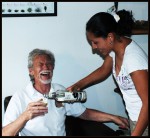
Earl Fish and Graciela Angeles. Mezcal de Los Angeles, Ocotlan
Is Mezcal in Crisis?
By Earl “Popeye” Fish
All photos by Alan (el Jaguar) Goodin
The most concise answer to that question is “That depends…”
In my short acquaintance, the lady has surely been growing up. What kind of woman will she be, or rather, is she becoming? There is still a bit of mystery for she is a débutante, barely come of age (even though she is pushing 500). As a mezcaloco my love affair is as a lover of a fine art that has the potential to be swamped in a sea of greed and destroyed.
I started out on a normal trip to visit some palenques, this time in the company of a photographer/writer and, ironically, a retiree from the California Department of Corrections, all in one, Alan Goodin. He is also, coincidentally, the editor and publisher of Jaguar Speaks http://www.morknme6.wordpress.com. I decided to start out with one of my favorite and more accessible valleys south of Oaxaca that wanders east from Ocotlan to Santa Catarina Minas and on to San Dionisio Ocotepec. I know lots of people there and as always, there is much more to be discovered.
First stop, Pancho Garcia.1. This guy makes some of the best pechuga I have had. I also kind of like the ornery old cuss that he is. The first time I met him, his daughter let me in the house and the old man came in from the other room.
“You Pancho Garcia?” I asked. “No, he’s dead,” the old man replied. “Who are you then?” “His ghost,” he smiled.
So Alan and I went first to the house. When there was no reply, we went a couple of blocks down the road to the palenque. From way in the back, behind the fermenting barrels, we got a reply to our hollering at the unlocked gate. I saw his sombrero and I started in as Pancho came out to meet us halfway. I could see right away that he was in one of his surely moods. “No pictures,” he said, as Alan raised the camera. “Que pasa, Maestro? We have come for some of your famous pechuga.”
“No hay, don’t have,” he replied. “There is no maguey.” And I remembered the cautionary note I had been given a couple months earlier by Erik Hernandez, one of the very knowledgeable producers. He produces for Ilegal and holds the Number One in registration numbers. He told me that all of the magueyes were being bought up by buyers from Jalisco and the price had quadrupled.
I asked Pancho, “But what about your exporter, he can’t help you?”
“We haven’t worked together for two years.”
“But, Maestro…”
“What! You don’t believe me?” Whoops! By the tone of his voice, Pancho was in one of his moods and there is no mollifying them. Time to leave!
Alan and I moved up the road a few hundred meters and found a new palenque that I hadn’t been to before. It was small and very traditional with clay stills. No horse, just a wooden ball bat to crush the cooked agave for fermenting. There was a young man and his mother who were very accommodating as they showed us around. We were taking production methods back 400 years. It almost made me forget Pancho—almost.
After lunch we proceeded to San Dionisio Ocotepec where some very good friends make Wahaka brand mezcal, which has been moving out into the US markets with good reception. As oftentimes happens, when I come unannounced, they were between production processes and there was not much action there.
We moved on to Matatlan (not far from Mitla), “The World’s Capital of Mezcal,” to complete our journey. Here we passed through Don Tacho’s place where they make Real Matlatl, another brand which is making very good progress in the U.S. with the help of Charles Collins, a crazy Irishman who has been exporting and distributing for the family. They were in the process of loading up the oven with some piňas of the espadin agave. There was no apparent shortage here, but then Don Tacho grows his own agave.
A good time was had as we watched and “helped,” load the horno. A few days in the oven (pit filled with red hot rocks) and it would be moved to the fermenting vats. Lastly, on the way out of Matalan, we passed through the new palenque that produces for La Niňa del Mezcal, the lady and the place where we held one of the first meetings of the mezcalocos.
It was here also that we made the first mezcal float. I think I broke the glass half-way through. Just as a ritual by the way. As we passed through Armando Hernandez was busy getting ready for the opening of his new restaurant on Easter Week. He also is busy making mezcal for the Niña and his brand Mal de Amor. A very nice end to a good day…
But, the crisis still loomed in the back of my mind. What about Pancho? What would happen to him, and were there more little guys that were going to be affected by the illegal action of the tequila giants? I was damned sure going to do little investigating with my friends in the mezcal world.
1The name has been changed to protect the guilty. Don’t want to piss off my man.
The Crisis
Then I read a full page article in Imparcial, one of the local newspapers.1
The header is that the tequileros are coming down to loot the agave used to make mezcal. It’s Ilegal! they’re shouting. Almost none of the agave from Oaxaca is the Blue Agave used to make tequila. The article pointed out that 79% of mezcal in Mexico2 comes from Oaxaca and of the 109 cases of adulteration detected only 12 were in Oaxaca. The article stresses that it will be the little producer, the small palenquero, who will be hurt… Pancho.
Earl turns Investigative Reporter.
The Imparcial article plus the memory of Pancho prods me into looking farther. I tried to talk to people I know in the trade.
My “interviews”, such as they were, consisted of bullshit between friends.3
One of the earlier bullshit sessions was with the Prof. I’d met Alberto a few years earlier, a short time after I’d read his book about mezcal4. He is a dedicated professor of agronomy at the Technological Institute and I mean a pro at the technical side of mezcal and proud to be a Mezcaloco. I wish I had a picture of this guy. What a face. I first spoke with him on the telephone. Yup! He’d heard. He was about to write something about that himself. “It is a cyclical thing.” he tells me. “They have been doing this every several years.” This is, of course, is a rough translation, but I think he might have used the word pendejos (assholes) somewhere in this conversation. I might be mistaken. That is a very unprofessor-like word to be throwing around.
Later, over a cup of coffee, the Prof offers to talk to a friend out in Santa Catarina about getting some agave for Pancho.
But mainly the crisis is a cyclical thing perpetrated every few years by the tequila people.
So, with a bit less enthusiasm and conviction, I keep asking around. I spoke with Leon Langel, at the Mezcaleria Los Amantes but he was at work and we did little more than trade bullshit. “Sure it’s __________, but some of the people growing the agave are making some dough this year. Here, have a shot.”
I move on that same night and talk with Sandra Ortiz Brena and Ulises Torrentera from In Situ.
In the process, Alan and I go out on another tour day. Poor Alan, sitting and smiling, had to sit, drink mezcal, and wait while I interviewed5 Graciela Angeles for an hour or so.
Probably more like so. Anyway, Graciela is one of my earlier attractions to the industry. For several reasons: she makes a very good if pricey hand-made joven mezcal called Real Minero http://www.realminero.com.mx. Along with that she is smart and very attractive. Along with that she is pretty. In brief, her summary: the price of agave has a small part to do with the price of the product, and yes, the tequileros have been thieving for years, and Pancho is just a rasty old fart. This is a newspaper. When you got some news… I toasted that. Course I toast damned near everything Graciela says.

Earl “Popeye” Fish
1Yes, unlike US cities, there are several. One might say many. And very different from one another
2Read, the world
3Tho some may not even want to be identified as friends. 🙂
4Oaxaca, Tierra de Agave y mezcal, Alberto Sanchez Lopez
5Read “Shmoozed”
Glossary for the Uninitiated
Palenque: In Oaxaca, a distillery. A palenquero is the head of the distillery.
The process of making mezcal:
The agave: Get it at its best. Just as it starts to flower and before all that good sugar heads upstairs. This can vary between 6 and more than 25 years depending a lot on the type of agave. There are more than a dozen types used to make mezcal, although 95% is made from the type espadin. How many types of agave is another storey altogether. There is a very good explanation on the web by the “Phd of Mezcal.” For those interested in mezcal, this is a very interesting blog site and this person does in fact have a Phd whereas I am a high school dropout.
Cut and cook: When the agave is ripe take it out, cut it up into reasonable sized chunks and put it in the oven, commonly called El Horno. The oven can be a hole in the ground lined with rocks and filled with burning coals which can vary a lot in size. I can also be a steam oven, sometimes used to conserve wood.
Grind it up: This can be done in many ways. The most common is with a horse drawn millstone wheel. Less formal is to put it into a concrete hole and beat it with a club. Some use machines of varying sizes.
Ferment: With a couple of exceptions the cooked fibers are put into a wooden fermenting vat. Those exceptions ferment only the juice in order to increase volume and reduce fermenting time.
Distill: Most stills are fashioned from copper. There are basically two other materials used in constructing a still: barro (an earthen clay pot) or stainless steel. Normally there are two distillations. There are exceptions like pechuga where fruit is added and for the third distillation a chicken breast is hung so the steam passes by to reduce the sweetness.
Aged: A practice not used so often with mezcal as it is with tequila. There are three types: not aged is called joven, less than year reposado, more than a year añejo. Aging is done less with wild agaves than the more common espadin. Unlike tequila, mezcal can be made from many types of agave or maguey and many of the subtle differences in taste can be lost in the aging process.